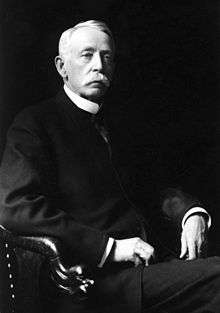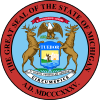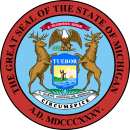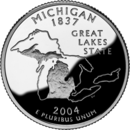Portal:Michigan
The Michigan Portal  Michigan (/ˈmɪʃɪɡən/ ⓘ MISH-ig-ən) is a state in the Great Lakes region of the Upper Midwestern United States. It shares water and land boundaries with Minnesota to the northwest, Wisconsin to the west, Indiana and Illinois to the southwest, Ohio to the southeast, and the Canadian province of Ontario to the east, northeast and north. With a population of 10.14 million and an area of 96,716 sq mi (250,490 km2), Michigan is the 10th-largest state by population, the 11th-largest by area, and the largest by total area east of the Mississippi River. The state capital is Lansing, while its most populous city is Detroit. The Metro Detroit region in Southeast Michigan is among the nation's most populous and largest metropolitan economies. Other important metropolitan areas include Grand Rapids, Flint, Ann Arbor, Kalamazoo, the Tri-Cities, and Muskegon. Michigan consists of two peninsulas: the heavily forested Upper Peninsula (commonly called "the U.P."), which juts eastward from northern Wisconsin, and the more populated Lower Peninsula, stretching north from Ohio and Indiana. The peninsulas are separated by the Straits of Mackinac, which connects Lake Michigan and Lake Huron, and are linked by the 5-mile-long Mackinac Bridge along Interstate 75. Bordering four of the five Great Lakes and Lake St. Clair, Michigan has the longest freshwater coastline of any U.S. political subdivision, measuring 3,288 miles. The state ranks second behind Alaska in water coverage by square miles and first in percentage, with approximately 42%, and it also contains 64,980 inland lakes and ponds. In the 17th century, French explorers claimed the Great Lakes region for New France, though the area had largely been inhabited for thousands of years by Indigenous peoples such as the Ojibwe, Odawa, Potawatomi, and Wyandot. French settlers and Métis established forts and settlements, with the region’s name derived from the Ojibwe word ᒥᓯᑲᒥ (mishigami), meaning "large water" or "large lake". After France's defeat in the French and Indian War in 1762, the area came under British control and later the U.S. following the Treaty of Paris (1783), though control remained disputed with Indigenous tribes until treaties between 1795 and 1842. The area was part of the larger Northwest Territory; the Michigan Territory was organized in 1805. Michigan was admitted as the 26th state on January 26, 1837, entering as a free state and quickly developing into an industrial and trade hub that attracted European immigrants, particularly from Finland, Macedonia, and the Netherlands. In the 1930s, migration from Appalachia and the Great Migration of Black Southerners further shaped the state, especially in Metro Detroit. Michigan has a diversified economy with a gross state product of $711.481 billion as of Q3 2024, ranking 14th among the 50 states. Although the state has developed a diverse economy, in the early 20th century it became widely known as the center of the U.S. automotive industry, which developed as a major national economic force. It is home to the country's three major automobile companies (whose headquarters are all in Metro Detroit). Once exploited for logging and mining, today the sparsely populated Upper Peninsula is important for tourism because of its abundance of natural resources. The Lower Peninsula is a center of manufacturing, forestry, agriculture, services, and high-tech industry. (Full article...) Entries here consist of Good and Featured articles, which meet a core set of high editorial standards.
 The Indiana Territory, officially the Territory of Indiana, was created by an organic act that President John Adams signed into law on May 7, 1800, to form an organized incorporated territory of the United States that existed from July 4, 1800, to December 11, 1816, when the remaining southeastern portion of the territory was admitted to the Union as the state of Indiana. The territory originally contained approximately 259,824 square miles (672,940 km2) of land, but its size was decreased when it was subdivided to create the Michigan Territory (1805) and the Illinois Territory (1809). The Indiana Territory was the first new territory created from lands of the Northwest Territory, which had been organized under the terms of the Northwest Ordinance of 1787. The territorial capital was the settlement around the old French fort of Vincennes on the Wabash River, until transferred to Corydon near the Ohio River in 1813. William Henry Harrison, the territory's first governor, oversaw treaty negotiations with the Native inhabitants that ceded tribal lands to the U.S. government, opening large parts of the territory to further settlement. In 1809 the U.S. Congress established a bicameral legislative body for the territory that included a popularly-elected House of Representatives and a Legislative Council. In addition, the territorial government began planning for a basic transportation network and education system, but efforts to attain statehood for the territory were delayed due to war. At the outbreak of Tecumseh's War, when the territory was on the front line of battle, Harrison led a military force in the opening hostilities at the Battle of Tippecanoe (1811) and in the subsequent invasion of Canada during the War of 1812. After Harrison resigned as the territorial governor, Thomas Posey was appointed to the vacant governorship, but the opposition party, led by Congressman Jonathan Jennings, dominated territorial affairs in its final years and began pressing for statehood. (Full article...) Selected picture - Campus Martius Park is a re-established park in downtown Detroit, Michigan. After the fire of 1805, Campus Martius (from the Latin for Field of Mars, where Roman heroes walked) was the focal point of judge Augustus Woodward's plans to rebuild the city. Did you know -
Related portalsSelected article -Catharine H. T. Avery (née, Tilden; December 13, 1844 - December 22, 1911) was an American author, editor, and educator of the long nineteenth century. Of Revolutionary ancestry and hailing from Michigan, she was founder and regent of the Western Reserve Chapter of the Daughters of the American Revolution (DAR), of Cleveland, Ohio; Vice-president General of its National Society; and editor of the National Society's official organ, the American Monthly. She also served two years as a member of the Cleveland School Board, being the first woman in Ohio chosen to an elective office. After the death of her father in 1861, she moved with her step-mother to Massachusetts. She was educated in the Normal School of that state and taught school in Massachusetts. Soon after the first meeting of the DAR, she became a member of the District of Columbia Society. The first president-general, Caroline Harrison, offered her the state regency of Ohio. She declined, but accepted the regent's commission for the Western Reserve Chapter, which she organized, the first in Ohio. In 1895, she was unanimously elected regent of the state. On retiring from the state regency, she was elected vice president-general from Ohio, and at the expiration of that term, the state bestowed upon her the life title "honorary state regent." From the time she joined the order until her death, 20 years later, she never relaxed her interest or activities in the work of the DAR in Ohio and the U.S. During the last 12 years of her life, she was editor of the American Monthly magazine, the official organ of the national society. Even earlier, she was a generous contributor to the newspapers on subjects which interested her. She was elected to membership in the Cleveland Woman's Press Club, twice serving as its president. She was its delegate to the conventions of the International League of Press Clubs held at Saint Paul, Minnesota and San Francisco, California. Avery was a close friend of Lydia Maria Child and attracted the notice of Wendell Phillips. (Full article...) Selected biography - Wellington R. Burt (August 26, 1831 – March 2, 1919) was an American lumber baron from Saginaw, Michigan. At the time of his death, his wealth was estimated to be between $40 and $90 million (equivalent to between $703 million and $1.58 billion in 2023). For a time in the early 1900s, Burt ranked as one of the eight wealthiest men in the United States. He was best known for his lumber mills and timber holdings, but was also involved in iron mining, railroads, salt mines, and finances. Burt was a politician, holding the offices of Mayor of East Saginaw (1867–68) and member of the Michigan Senate (1893–94). In his final years, he lived alone in a mansion with his servants. Estranged from friends and family and nicknamed "The Lone Pine of Michigan", he officially died of "senility" at age 87. Burt had an unusual will, "as bizarre but as finely-wrought as any in U.S. court annals". It contained a "spite clause" conceived by Burt to avenge a family feud. It specified to wait 21 years after his children and grandchildren were dead before the bulk of the fortune could go to any descendants, in effect alienating his children and grandchildren from the estate, beyond some small annuities. The conditions of the will were met in 2010 after the 1989 death of his last grandchild. In May 2011, twelve of Burt's descendants finally received the estate, worth about $100 million. (Full article...) General imagesThe following are images from various Michigan-related articles on Wikipedia.
TopicsCategoriesSymbols
Lists
Related pagesWikimediaThe following Wikimedia Foundation sister projects provide more on this subject:
Things you can doDiscover Wikipedia using portals | ||||||||||||||||||||||||||||||||||||














































































